MITS5002 - Cloud Computing: Issues and Challenges Research Report
VerifiedAdded on 2022/12/26
|9
|2355
|75
Report
AI Summary
This report provides a comprehensive overview of the issues and challenges associated with cloud computing. It begins with an introduction that highlights the transformative impact of cloud technology across various industries, emphasizing its influence on the IT sector and organizational structures. The report delves into the definition of cloud computing, as defined by NIST, and discusses its key elements, including resource pooling, rapid elasticity, and on-demand self-service. It explores various service models, such as Software as a Service (SaaS), Platform as a Service (PaaS), Infrastructure as a Service (IaaS), and Data Storage as a Service (DaaS), providing examples for each. The report then addresses the challenges faced in cloud adoption, including security concerns, cost models, charging models, Service Level Agreements (SLAs), service migration, and interoperability issues. It emphasizes the importance of security, the impact of cost factors, and the need for effective SLAs. Furthermore, the report discusses interoperability challenges, vendor lock-in, and the integration of cloud services. The conclusion summarizes the key findings and emphasizes the need for addressing these challenges to fully leverage the benefits of cloud computing. The report includes references to relevant academic papers to support its analysis.
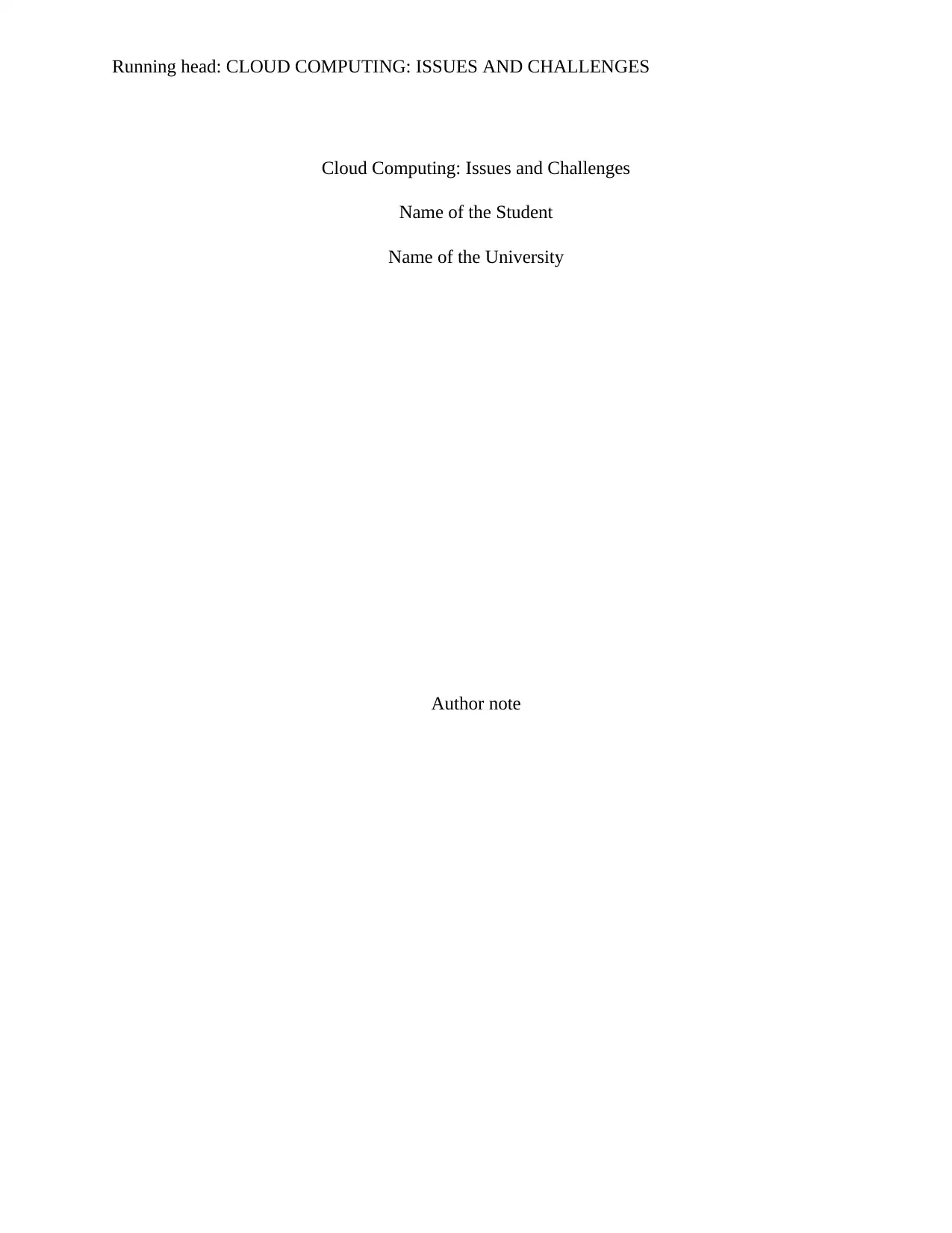
Running head: CLOUD COMPUTING: ISSUES AND CHALLENGES
Cloud Computing: Issues and Challenges
Name of the Student
Name of the University
Author note
Cloud Computing: Issues and Challenges
Name of the Student
Name of the University
Author note
Paraphrase This Document
Need a fresh take? Get an instant paraphrase of this document with our AI Paraphraser
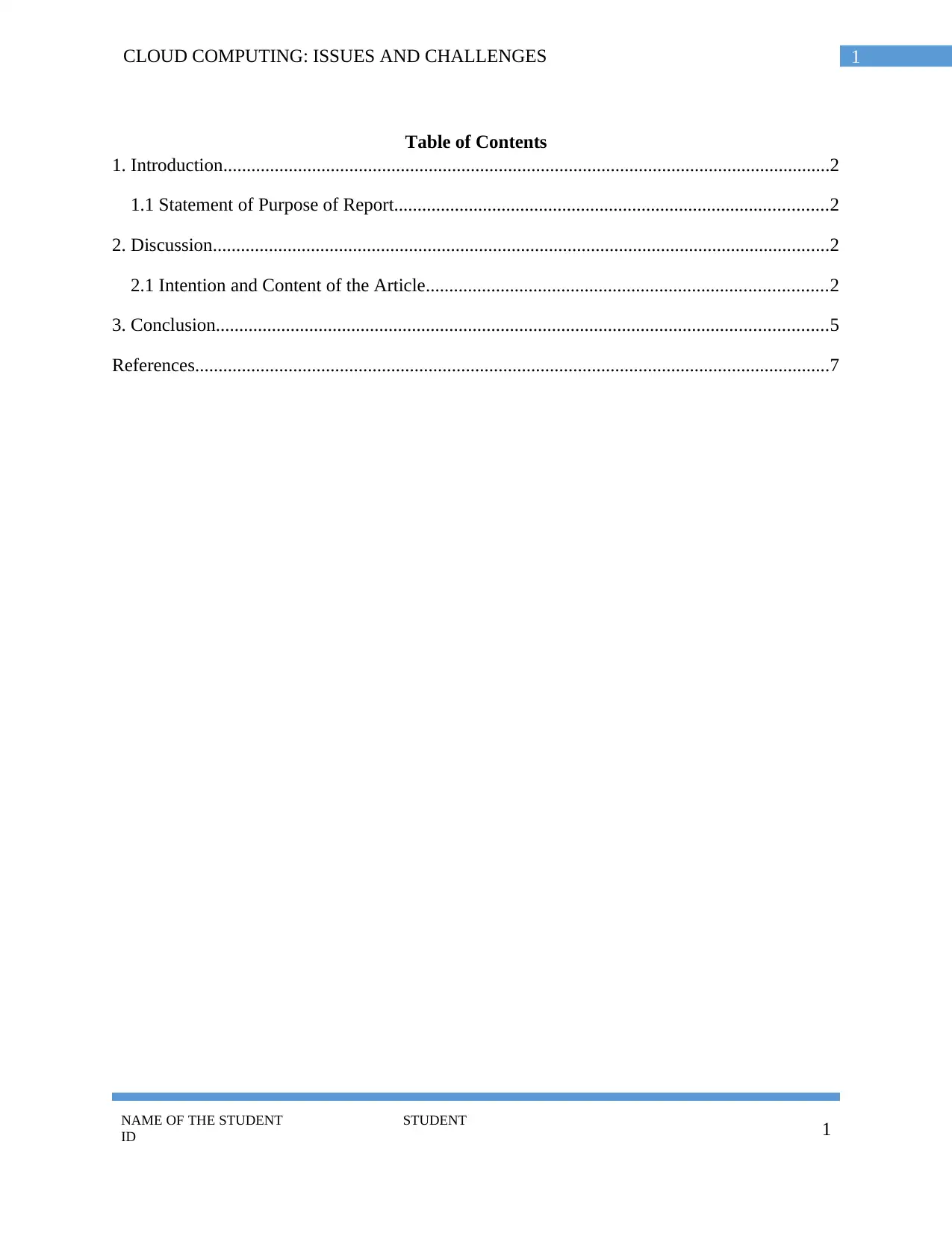
1CLOUD COMPUTING: ISSUES AND CHALLENGES
Table of Contents
1. Introduction..................................................................................................................................2
1.1 Statement of Purpose of Report.............................................................................................2
2. Discussion....................................................................................................................................2
2.1 Intention and Content of the Article......................................................................................2
3. Conclusion...................................................................................................................................5
References........................................................................................................................................7
NAME OF THE STUDENT STUDENT
ID 1
Table of Contents
1. Introduction..................................................................................................................................2
1.1 Statement of Purpose of Report.............................................................................................2
2. Discussion....................................................................................................................................2
2.1 Intention and Content of the Article......................................................................................2
3. Conclusion...................................................................................................................................5
References........................................................................................................................................7
NAME OF THE STUDENT STUDENT
ID 1
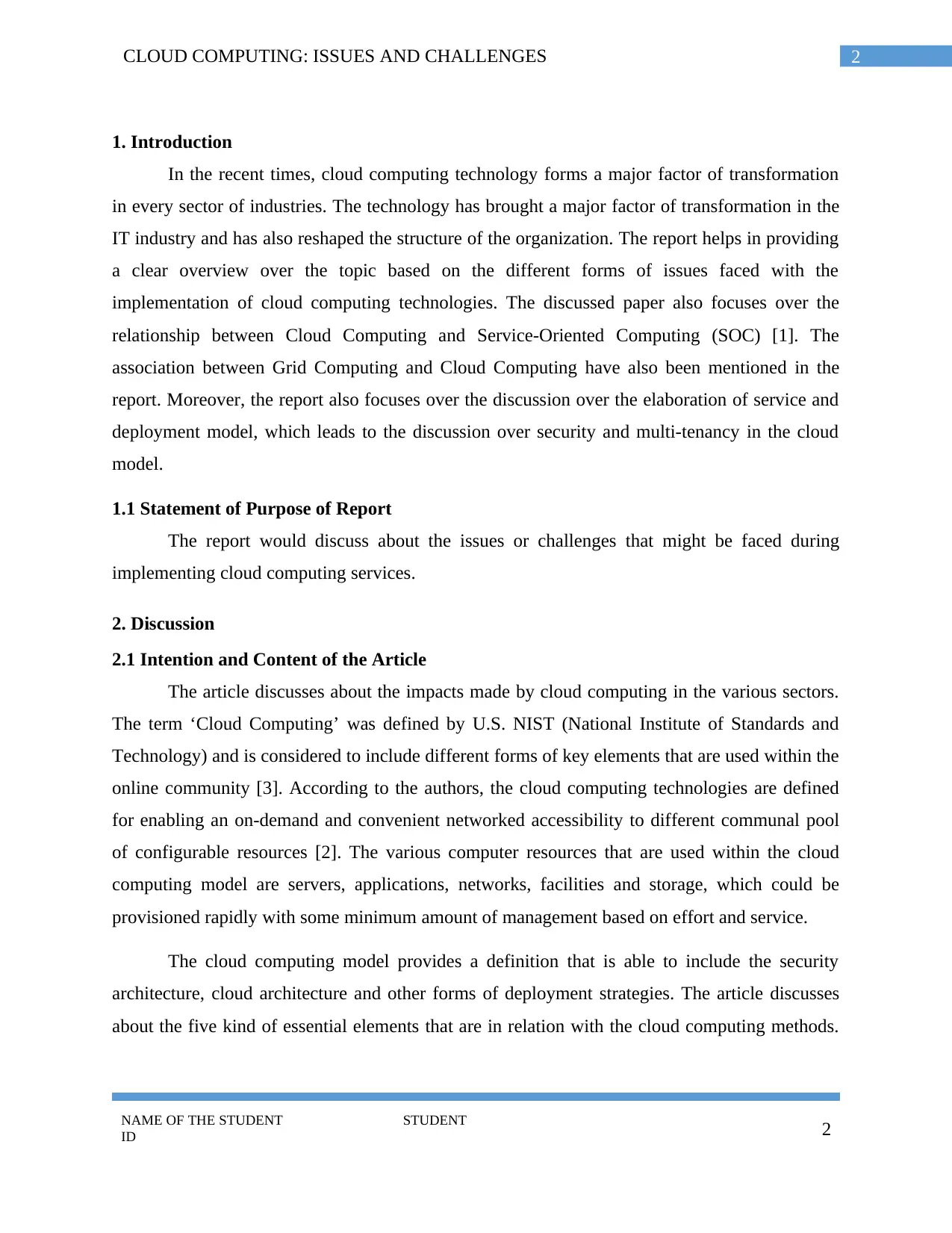
2CLOUD COMPUTING: ISSUES AND CHALLENGES
1. Introduction
In the recent times, cloud computing technology forms a major factor of transformation
in every sector of industries. The technology has brought a major factor of transformation in the
IT industry and has also reshaped the structure of the organization. The report helps in providing
a clear overview over the topic based on the different forms of issues faced with the
implementation of cloud computing technologies. The discussed paper also focuses over the
relationship between Cloud Computing and Service-Oriented Computing (SOC) [1]. The
association between Grid Computing and Cloud Computing have also been mentioned in the
report. Moreover, the report also focuses over the discussion over the elaboration of service and
deployment model, which leads to the discussion over security and multi-tenancy in the cloud
model.
1.1 Statement of Purpose of Report
The report would discuss about the issues or challenges that might be faced during
implementing cloud computing services.
2. Discussion
2.1 Intention and Content of the Article
The article discusses about the impacts made by cloud computing in the various sectors.
The term ‘Cloud Computing’ was defined by U.S. NIST (National Institute of Standards and
Technology) and is considered to include different forms of key elements that are used within the
online community [3]. According to the authors, the cloud computing technologies are defined
for enabling an on-demand and convenient networked accessibility to different communal pool
of configurable resources [2]. The various computer resources that are used within the cloud
computing model are servers, applications, networks, facilities and storage, which could be
provisioned rapidly with some minimum amount of management based on effort and service.
The cloud computing model provides a definition that is able to include the security
architecture, cloud architecture and other forms of deployment strategies. The article discusses
about the five kind of essential elements that are in relation with the cloud computing methods.
NAME OF THE STUDENT STUDENT
ID 2
1. Introduction
In the recent times, cloud computing technology forms a major factor of transformation
in every sector of industries. The technology has brought a major factor of transformation in the
IT industry and has also reshaped the structure of the organization. The report helps in providing
a clear overview over the topic based on the different forms of issues faced with the
implementation of cloud computing technologies. The discussed paper also focuses over the
relationship between Cloud Computing and Service-Oriented Computing (SOC) [1]. The
association between Grid Computing and Cloud Computing have also been mentioned in the
report. Moreover, the report also focuses over the discussion over the elaboration of service and
deployment model, which leads to the discussion over security and multi-tenancy in the cloud
model.
1.1 Statement of Purpose of Report
The report would discuss about the issues or challenges that might be faced during
implementing cloud computing services.
2. Discussion
2.1 Intention and Content of the Article
The article discusses about the impacts made by cloud computing in the various sectors.
The term ‘Cloud Computing’ was defined by U.S. NIST (National Institute of Standards and
Technology) and is considered to include different forms of key elements that are used within the
online community [3]. According to the authors, the cloud computing technologies are defined
for enabling an on-demand and convenient networked accessibility to different communal pool
of configurable resources [2]. The various computer resources that are used within the cloud
computing model are servers, applications, networks, facilities and storage, which could be
provisioned rapidly with some minimum amount of management based on effort and service.
The cloud computing model provides a definition that is able to include the security
architecture, cloud architecture and other forms of deployment strategies. The article discusses
about the five kind of essential elements that are in relation with the cloud computing methods.
NAME OF THE STUDENT STUDENT
ID 2
⊘ This is a preview!⊘
Do you want full access?
Subscribe today to unlock all pages.

Trusted by 1+ million students worldwide
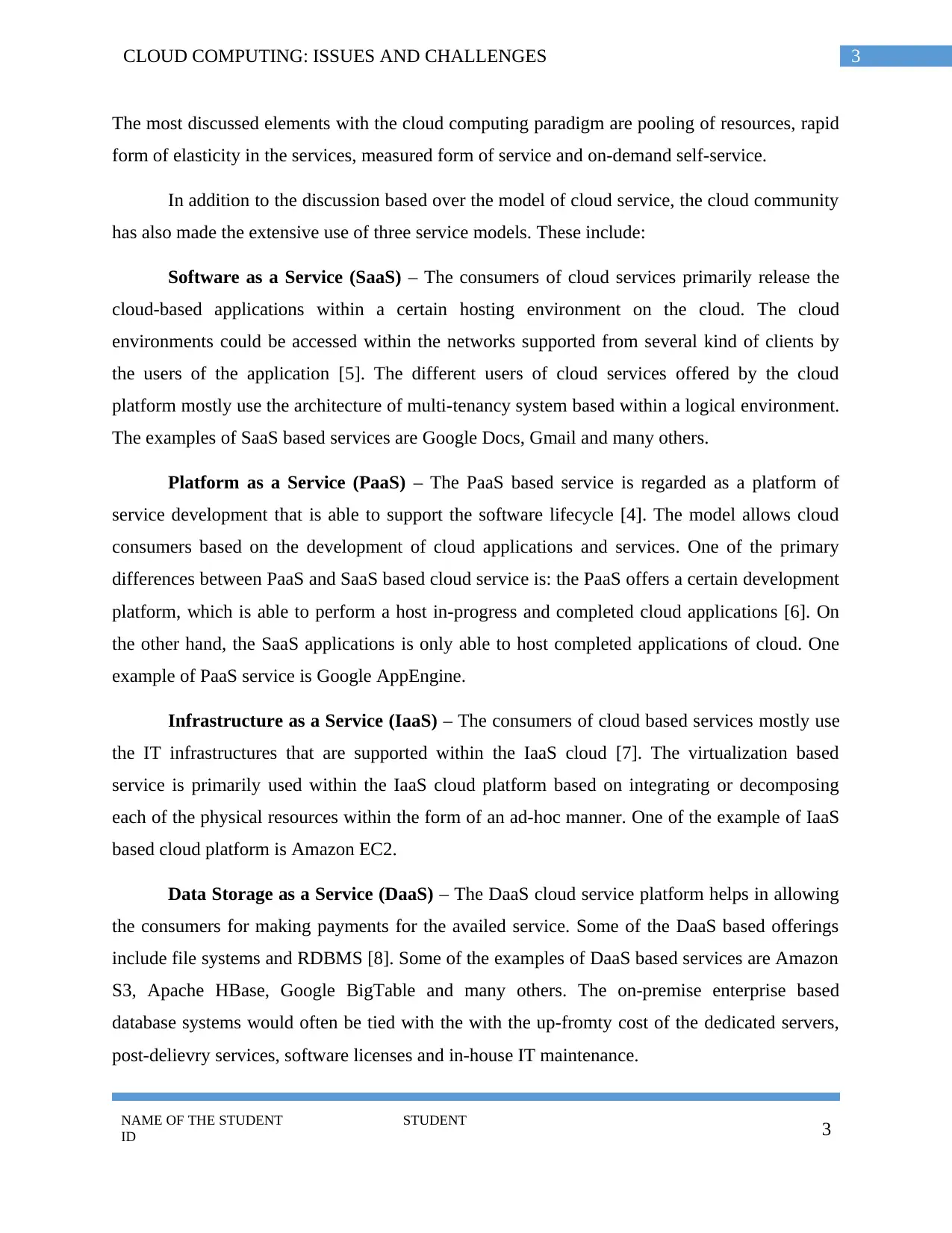
3CLOUD COMPUTING: ISSUES AND CHALLENGES
The most discussed elements with the cloud computing paradigm are pooling of resources, rapid
form of elasticity in the services, measured form of service and on-demand self-service.
In addition to the discussion based over the model of cloud service, the cloud community
has also made the extensive use of three service models. These include:
Software as a Service (SaaS) – The consumers of cloud services primarily release the
cloud-based applications within a certain hosting environment on the cloud. The cloud
environments could be accessed within the networks supported from several kind of clients by
the users of the application [5]. The different users of cloud services offered by the cloud
platform mostly use the architecture of multi-tenancy system based within a logical environment.
The examples of SaaS based services are Google Docs, Gmail and many others.
Platform as a Service (PaaS) – The PaaS based service is regarded as a platform of
service development that is able to support the software lifecycle [4]. The model allows cloud
consumers based on the development of cloud applications and services. One of the primary
differences between PaaS and SaaS based cloud service is: the PaaS offers a certain development
platform, which is able to perform a host in-progress and completed cloud applications [6]. On
the other hand, the SaaS applications is only able to host completed applications of cloud. One
example of PaaS service is Google AppEngine.
Infrastructure as a Service (IaaS) – The consumers of cloud based services mostly use
the IT infrastructures that are supported within the IaaS cloud [7]. The virtualization based
service is primarily used within the IaaS cloud platform based on integrating or decomposing
each of the physical resources within the form of an ad-hoc manner. One of the example of IaaS
based cloud platform is Amazon EC2.
Data Storage as a Service (DaaS) – The DaaS cloud service platform helps in allowing
the consumers for making payments for the availed service. Some of the DaaS based offerings
include file systems and RDBMS [8]. Some of the examples of DaaS based services are Amazon
S3, Apache HBase, Google BigTable and many others. The on-premise enterprise based
database systems would often be tied with the with the up-fromty cost of the dedicated servers,
post-delievry services, software licenses and in-house IT maintenance.
NAME OF THE STUDENT STUDENT
ID 3
The most discussed elements with the cloud computing paradigm are pooling of resources, rapid
form of elasticity in the services, measured form of service and on-demand self-service.
In addition to the discussion based over the model of cloud service, the cloud community
has also made the extensive use of three service models. These include:
Software as a Service (SaaS) – The consumers of cloud services primarily release the
cloud-based applications within a certain hosting environment on the cloud. The cloud
environments could be accessed within the networks supported from several kind of clients by
the users of the application [5]. The different users of cloud services offered by the cloud
platform mostly use the architecture of multi-tenancy system based within a logical environment.
The examples of SaaS based services are Google Docs, Gmail and many others.
Platform as a Service (PaaS) – The PaaS based service is regarded as a platform of
service development that is able to support the software lifecycle [4]. The model allows cloud
consumers based on the development of cloud applications and services. One of the primary
differences between PaaS and SaaS based cloud service is: the PaaS offers a certain development
platform, which is able to perform a host in-progress and completed cloud applications [6]. On
the other hand, the SaaS applications is only able to host completed applications of cloud. One
example of PaaS service is Google AppEngine.
Infrastructure as a Service (IaaS) – The consumers of cloud based services mostly use
the IT infrastructures that are supported within the IaaS cloud [7]. The virtualization based
service is primarily used within the IaaS cloud platform based on integrating or decomposing
each of the physical resources within the form of an ad-hoc manner. One of the example of IaaS
based cloud platform is Amazon EC2.
Data Storage as a Service (DaaS) – The DaaS cloud service platform helps in allowing
the consumers for making payments for the availed service. Some of the DaaS based offerings
include file systems and RDBMS [8]. Some of the examples of DaaS based services are Amazon
S3, Apache HBase, Google BigTable and many others. The on-premise enterprise based
database systems would often be tied with the with the up-fromty cost of the dedicated servers,
post-delievry services, software licenses and in-house IT maintenance.
NAME OF THE STUDENT STUDENT
ID 3
Paraphrase This Document
Need a fresh take? Get an instant paraphrase of this document with our AI Paraphraser
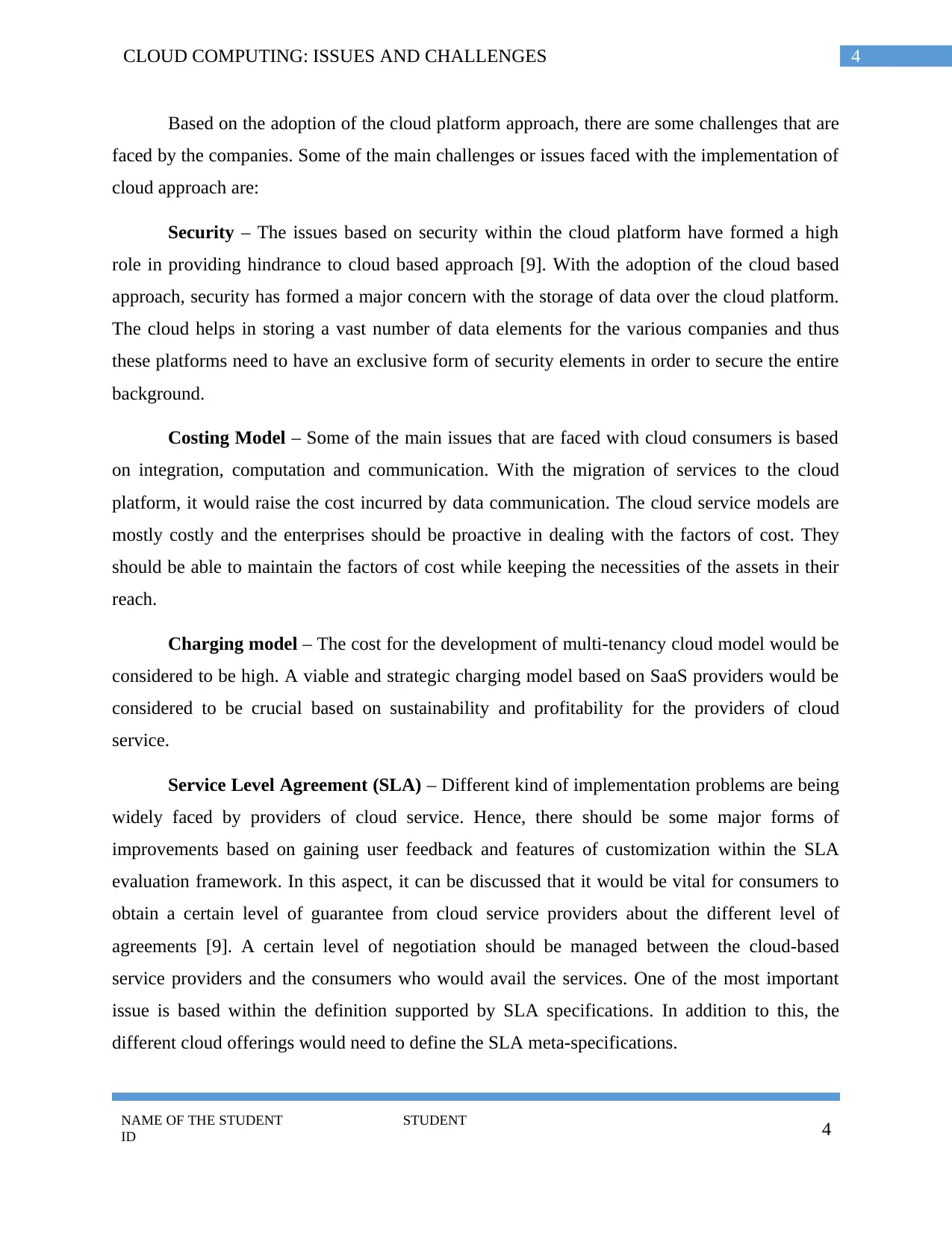
4CLOUD COMPUTING: ISSUES AND CHALLENGES
Based on the adoption of the cloud platform approach, there are some challenges that are
faced by the companies. Some of the main challenges or issues faced with the implementation of
cloud approach are:
Security – The issues based on security within the cloud platform have formed a high
role in providing hindrance to cloud based approach [9]. With the adoption of the cloud based
approach, security has formed a major concern with the storage of data over the cloud platform.
The cloud helps in storing a vast number of data elements for the various companies and thus
these platforms need to have an exclusive form of security elements in order to secure the entire
background.
Costing Model – Some of the main issues that are faced with cloud consumers is based
on integration, computation and communication. With the migration of services to the cloud
platform, it would raise the cost incurred by data communication. The cloud service models are
mostly costly and the enterprises should be proactive in dealing with the factors of cost. They
should be able to maintain the factors of cost while keeping the necessities of the assets in their
reach.
Charging model – The cost for the development of multi-tenancy cloud model would be
considered to be high. A viable and strategic charging model based on SaaS providers would be
considered to be crucial based on sustainability and profitability for the providers of cloud
service.
Service Level Agreement (SLA) – Different kind of implementation problems are being
widely faced by providers of cloud service. Hence, there should be some major forms of
improvements based on gaining user feedback and features of customization within the SLA
evaluation framework. In this aspect, it can be discussed that it would be vital for consumers to
obtain a certain level of guarantee from cloud service providers about the different level of
agreements [9]. A certain level of negotiation should be managed between the cloud-based
service providers and the consumers who would avail the services. One of the most important
issue is based within the definition supported by SLA specifications. In addition to this, the
different cloud offerings would need to define the SLA meta-specifications.
NAME OF THE STUDENT STUDENT
ID 4
Based on the adoption of the cloud platform approach, there are some challenges that are
faced by the companies. Some of the main challenges or issues faced with the implementation of
cloud approach are:
Security – The issues based on security within the cloud platform have formed a high
role in providing hindrance to cloud based approach [9]. With the adoption of the cloud based
approach, security has formed a major concern with the storage of data over the cloud platform.
The cloud helps in storing a vast number of data elements for the various companies and thus
these platforms need to have an exclusive form of security elements in order to secure the entire
background.
Costing Model – Some of the main issues that are faced with cloud consumers is based
on integration, computation and communication. With the migration of services to the cloud
platform, it would raise the cost incurred by data communication. The cloud service models are
mostly costly and the enterprises should be proactive in dealing with the factors of cost. They
should be able to maintain the factors of cost while keeping the necessities of the assets in their
reach.
Charging model – The cost for the development of multi-tenancy cloud model would be
considered to be high. A viable and strategic charging model based on SaaS providers would be
considered to be crucial based on sustainability and profitability for the providers of cloud
service.
Service Level Agreement (SLA) – Different kind of implementation problems are being
widely faced by providers of cloud service. Hence, there should be some major forms of
improvements based on gaining user feedback and features of customization within the SLA
evaluation framework. In this aspect, it can be discussed that it would be vital for consumers to
obtain a certain level of guarantee from cloud service providers about the different level of
agreements [9]. A certain level of negotiation should be managed between the cloud-based
service providers and the consumers who would avail the services. One of the most important
issue is based within the definition supported by SLA specifications. In addition to this, the
different cloud offerings would need to define the SLA meta-specifications.
NAME OF THE STUDENT STUDENT
ID 4
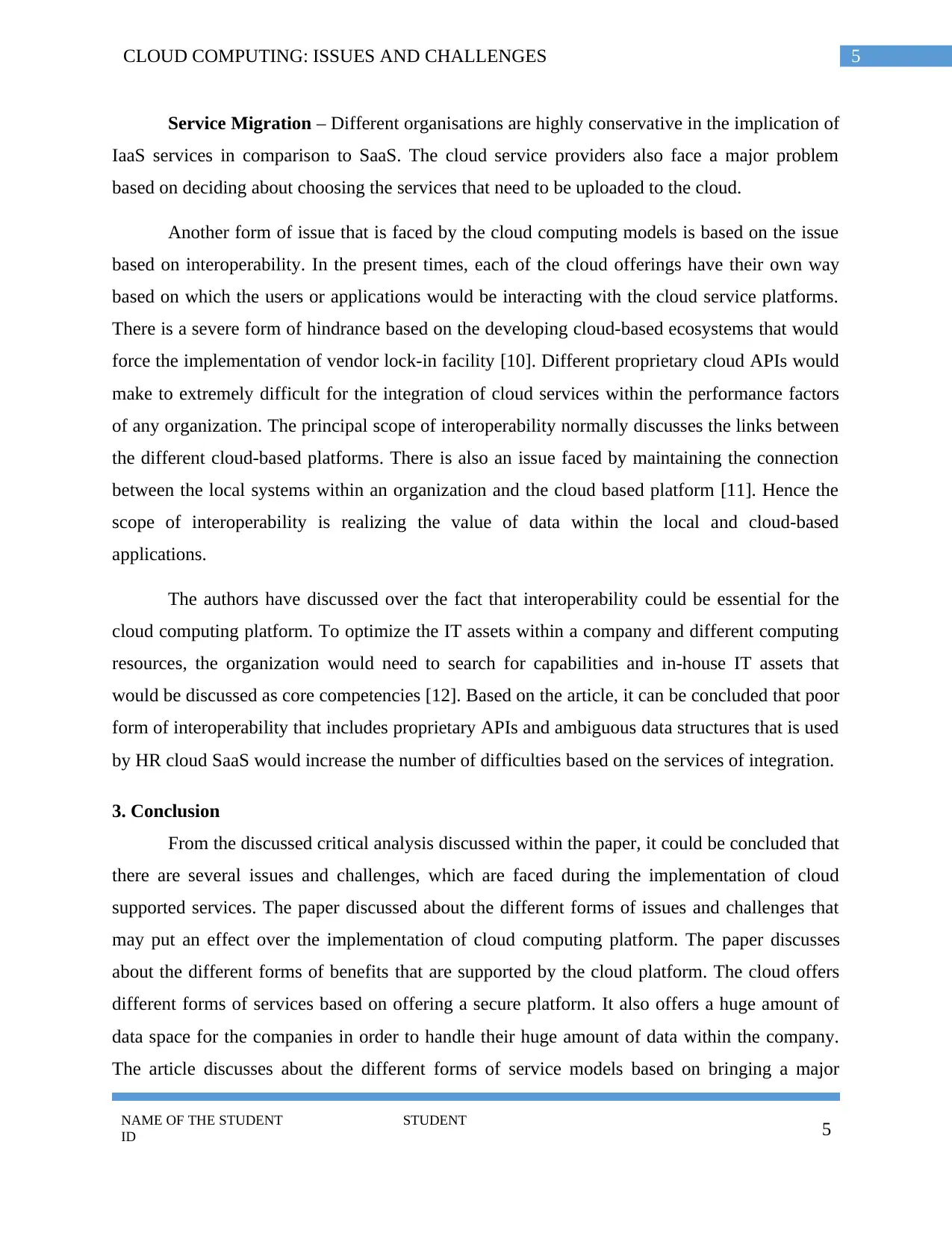
5CLOUD COMPUTING: ISSUES AND CHALLENGES
Service Migration – Different organisations are highly conservative in the implication of
IaaS services in comparison to SaaS. The cloud service providers also face a major problem
based on deciding about choosing the services that need to be uploaded to the cloud.
Another form of issue that is faced by the cloud computing models is based on the issue
based on interoperability. In the present times, each of the cloud offerings have their own way
based on which the users or applications would be interacting with the cloud service platforms.
There is a severe form of hindrance based on the developing cloud-based ecosystems that would
force the implementation of vendor lock-in facility [10]. Different proprietary cloud APIs would
make to extremely difficult for the integration of cloud services within the performance factors
of any organization. The principal scope of interoperability normally discusses the links between
the different cloud-based platforms. There is also an issue faced by maintaining the connection
between the local systems within an organization and the cloud based platform [11]. Hence the
scope of interoperability is realizing the value of data within the local and cloud-based
applications.
The authors have discussed over the fact that interoperability could be essential for the
cloud computing platform. To optimize the IT assets within a company and different computing
resources, the organization would need to search for capabilities and in-house IT assets that
would be discussed as core competencies [12]. Based on the article, it can be concluded that poor
form of interoperability that includes proprietary APIs and ambiguous data structures that is used
by HR cloud SaaS would increase the number of difficulties based on the services of integration.
3. Conclusion
From the discussed critical analysis discussed within the paper, it could be concluded that
there are several issues and challenges, which are faced during the implementation of cloud
supported services. The paper discussed about the different forms of issues and challenges that
may put an effect over the implementation of cloud computing platform. The paper discusses
about the different forms of benefits that are supported by the cloud platform. The cloud offers
different forms of services based on offering a secure platform. It also offers a huge amount of
data space for the companies in order to handle their huge amount of data within the company.
The article discusses about the different forms of service models based on bringing a major
NAME OF THE STUDENT STUDENT
ID 5
Service Migration – Different organisations are highly conservative in the implication of
IaaS services in comparison to SaaS. The cloud service providers also face a major problem
based on deciding about choosing the services that need to be uploaded to the cloud.
Another form of issue that is faced by the cloud computing models is based on the issue
based on interoperability. In the present times, each of the cloud offerings have their own way
based on which the users or applications would be interacting with the cloud service platforms.
There is a severe form of hindrance based on the developing cloud-based ecosystems that would
force the implementation of vendor lock-in facility [10]. Different proprietary cloud APIs would
make to extremely difficult for the integration of cloud services within the performance factors
of any organization. The principal scope of interoperability normally discusses the links between
the different cloud-based platforms. There is also an issue faced by maintaining the connection
between the local systems within an organization and the cloud based platform [11]. Hence the
scope of interoperability is realizing the value of data within the local and cloud-based
applications.
The authors have discussed over the fact that interoperability could be essential for the
cloud computing platform. To optimize the IT assets within a company and different computing
resources, the organization would need to search for capabilities and in-house IT assets that
would be discussed as core competencies [12]. Based on the article, it can be concluded that poor
form of interoperability that includes proprietary APIs and ambiguous data structures that is used
by HR cloud SaaS would increase the number of difficulties based on the services of integration.
3. Conclusion
From the discussed critical analysis discussed within the paper, it could be concluded that
there are several issues and challenges, which are faced during the implementation of cloud
supported services. The paper discussed about the different forms of issues and challenges that
may put an effect over the implementation of cloud computing platform. The paper discusses
about the different forms of benefits that are supported by the cloud platform. The cloud offers
different forms of services based on offering a secure platform. It also offers a huge amount of
data space for the companies in order to handle their huge amount of data within the company.
The article discusses about the different forms of service models based on bringing a major
NAME OF THE STUDENT STUDENT
ID 5
⊘ This is a preview!⊘
Do you want full access?
Subscribe today to unlock all pages.

Trusted by 1+ million students worldwide
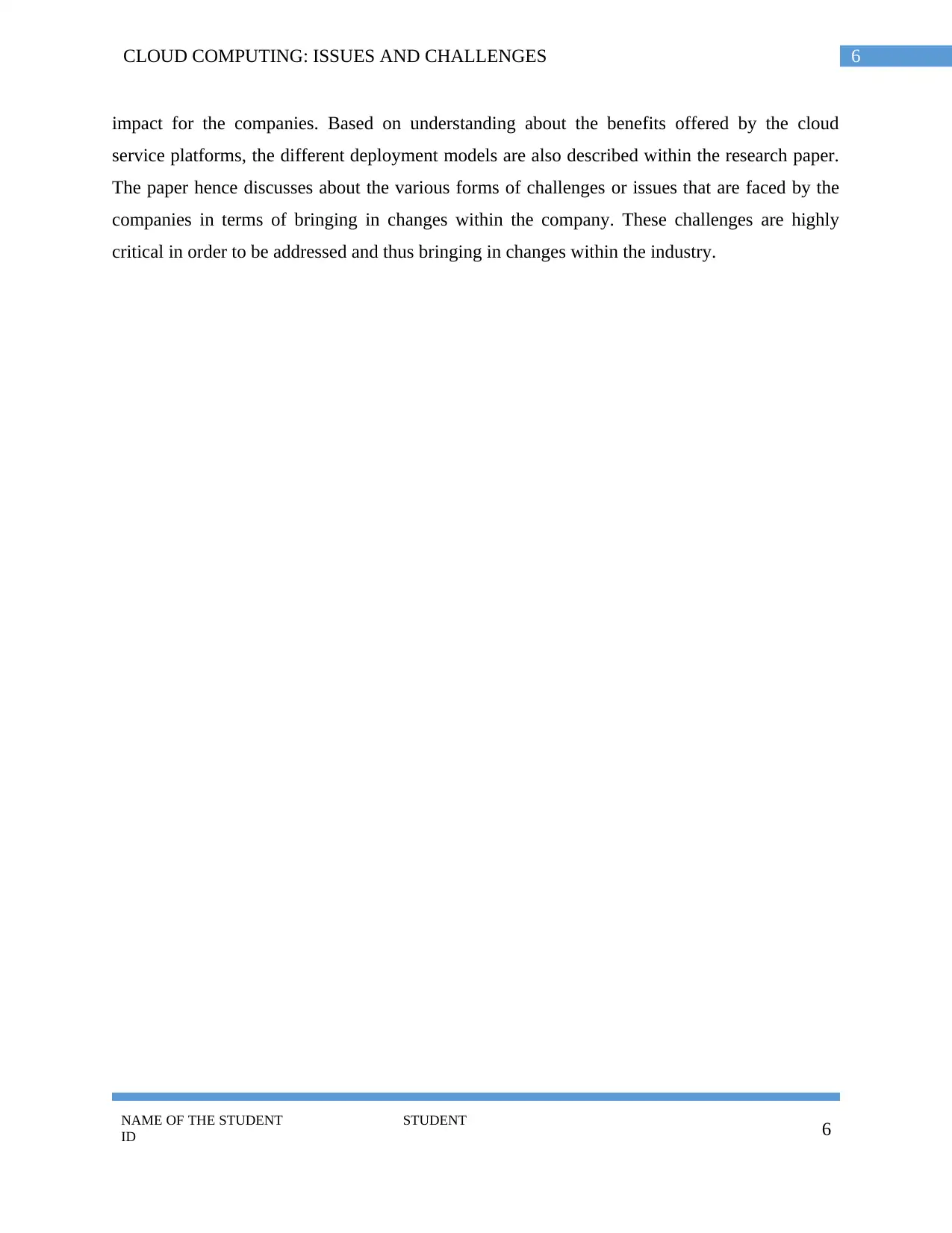
6CLOUD COMPUTING: ISSUES AND CHALLENGES
impact for the companies. Based on understanding about the benefits offered by the cloud
service platforms, the different deployment models are also described within the research paper.
The paper hence discusses about the various forms of challenges or issues that are faced by the
companies in terms of bringing in changes within the company. These challenges are highly
critical in order to be addressed and thus bringing in changes within the industry.
NAME OF THE STUDENT STUDENT
ID 6
impact for the companies. Based on understanding about the benefits offered by the cloud
service platforms, the different deployment models are also described within the research paper.
The paper hence discusses about the various forms of challenges or issues that are faced by the
companies in terms of bringing in changes within the company. These challenges are highly
critical in order to be addressed and thus bringing in changes within the industry.
NAME OF THE STUDENT STUDENT
ID 6
Paraphrase This Document
Need a fresh take? Get an instant paraphrase of this document with our AI Paraphraser
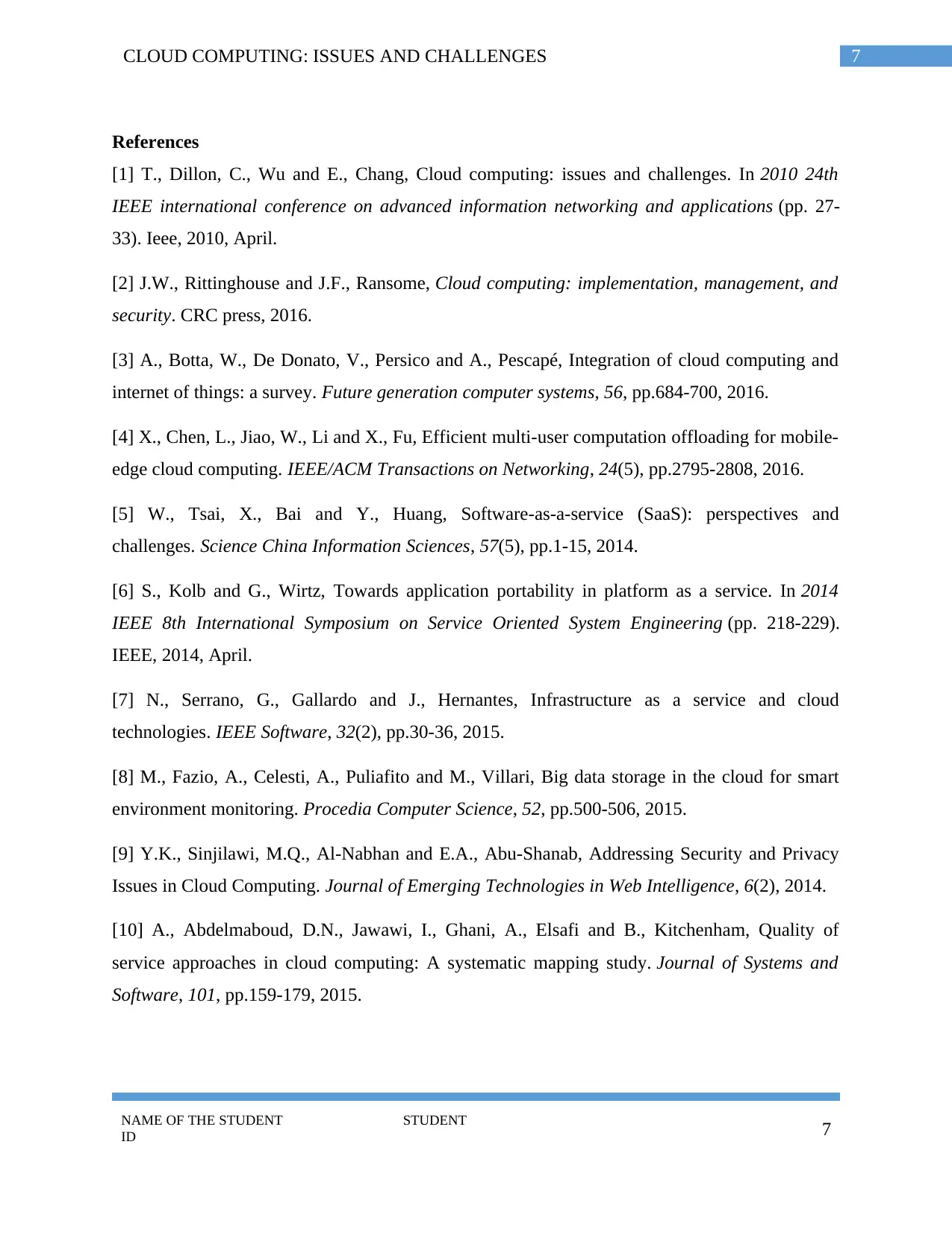
7CLOUD COMPUTING: ISSUES AND CHALLENGES
References
[1] T., Dillon, C., Wu and E., Chang, Cloud computing: issues and challenges. In 2010 24th
IEEE international conference on advanced information networking and applications (pp. 27-
33). Ieee, 2010, April.
[2] J.W., Rittinghouse and J.F., Ransome, Cloud computing: implementation, management, and
security. CRC press, 2016.
[3] A., Botta, W., De Donato, V., Persico and A., Pescapé, Integration of cloud computing and
internet of things: a survey. Future generation computer systems, 56, pp.684-700, 2016.
[4] X., Chen, L., Jiao, W., Li and X., Fu, Efficient multi-user computation offloading for mobile-
edge cloud computing. IEEE/ACM Transactions on Networking, 24(5), pp.2795-2808, 2016.
[5] W., Tsai, X., Bai and Y., Huang, Software-as-a-service (SaaS): perspectives and
challenges. Science China Information Sciences, 57(5), pp.1-15, 2014.
[6] S., Kolb and G., Wirtz, Towards application portability in platform as a service. In 2014
IEEE 8th International Symposium on Service Oriented System Engineering (pp. 218-229).
IEEE, 2014, April.
[7] N., Serrano, G., Gallardo and J., Hernantes, Infrastructure as a service and cloud
technologies. IEEE Software, 32(2), pp.30-36, 2015.
[8] M., Fazio, A., Celesti, A., Puliafito and M., Villari, Big data storage in the cloud for smart
environment monitoring. Procedia Computer Science, 52, pp.500-506, 2015.
[9] Y.K., Sinjilawi, M.Q., Al-Nabhan and E.A., Abu-Shanab, Addressing Security and Privacy
Issues in Cloud Computing. Journal of Emerging Technologies in Web Intelligence, 6(2), 2014.
[10] A., Abdelmaboud, D.N., Jawawi, I., Ghani, A., Elsafi and B., Kitchenham, Quality of
service approaches in cloud computing: A systematic mapping study. Journal of Systems and
Software, 101, pp.159-179, 2015.
NAME OF THE STUDENT STUDENT
ID 7
References
[1] T., Dillon, C., Wu and E., Chang, Cloud computing: issues and challenges. In 2010 24th
IEEE international conference on advanced information networking and applications (pp. 27-
33). Ieee, 2010, April.
[2] J.W., Rittinghouse and J.F., Ransome, Cloud computing: implementation, management, and
security. CRC press, 2016.
[3] A., Botta, W., De Donato, V., Persico and A., Pescapé, Integration of cloud computing and
internet of things: a survey. Future generation computer systems, 56, pp.684-700, 2016.
[4] X., Chen, L., Jiao, W., Li and X., Fu, Efficient multi-user computation offloading for mobile-
edge cloud computing. IEEE/ACM Transactions on Networking, 24(5), pp.2795-2808, 2016.
[5] W., Tsai, X., Bai and Y., Huang, Software-as-a-service (SaaS): perspectives and
challenges. Science China Information Sciences, 57(5), pp.1-15, 2014.
[6] S., Kolb and G., Wirtz, Towards application portability in platform as a service. In 2014
IEEE 8th International Symposium on Service Oriented System Engineering (pp. 218-229).
IEEE, 2014, April.
[7] N., Serrano, G., Gallardo and J., Hernantes, Infrastructure as a service and cloud
technologies. IEEE Software, 32(2), pp.30-36, 2015.
[8] M., Fazio, A., Celesti, A., Puliafito and M., Villari, Big data storage in the cloud for smart
environment monitoring. Procedia Computer Science, 52, pp.500-506, 2015.
[9] Y.K., Sinjilawi, M.Q., Al-Nabhan and E.A., Abu-Shanab, Addressing Security and Privacy
Issues in Cloud Computing. Journal of Emerging Technologies in Web Intelligence, 6(2), 2014.
[10] A., Abdelmaboud, D.N., Jawawi, I., Ghani, A., Elsafi and B., Kitchenham, Quality of
service approaches in cloud computing: A systematic mapping study. Journal of Systems and
Software, 101, pp.159-179, 2015.
NAME OF THE STUDENT STUDENT
ID 7
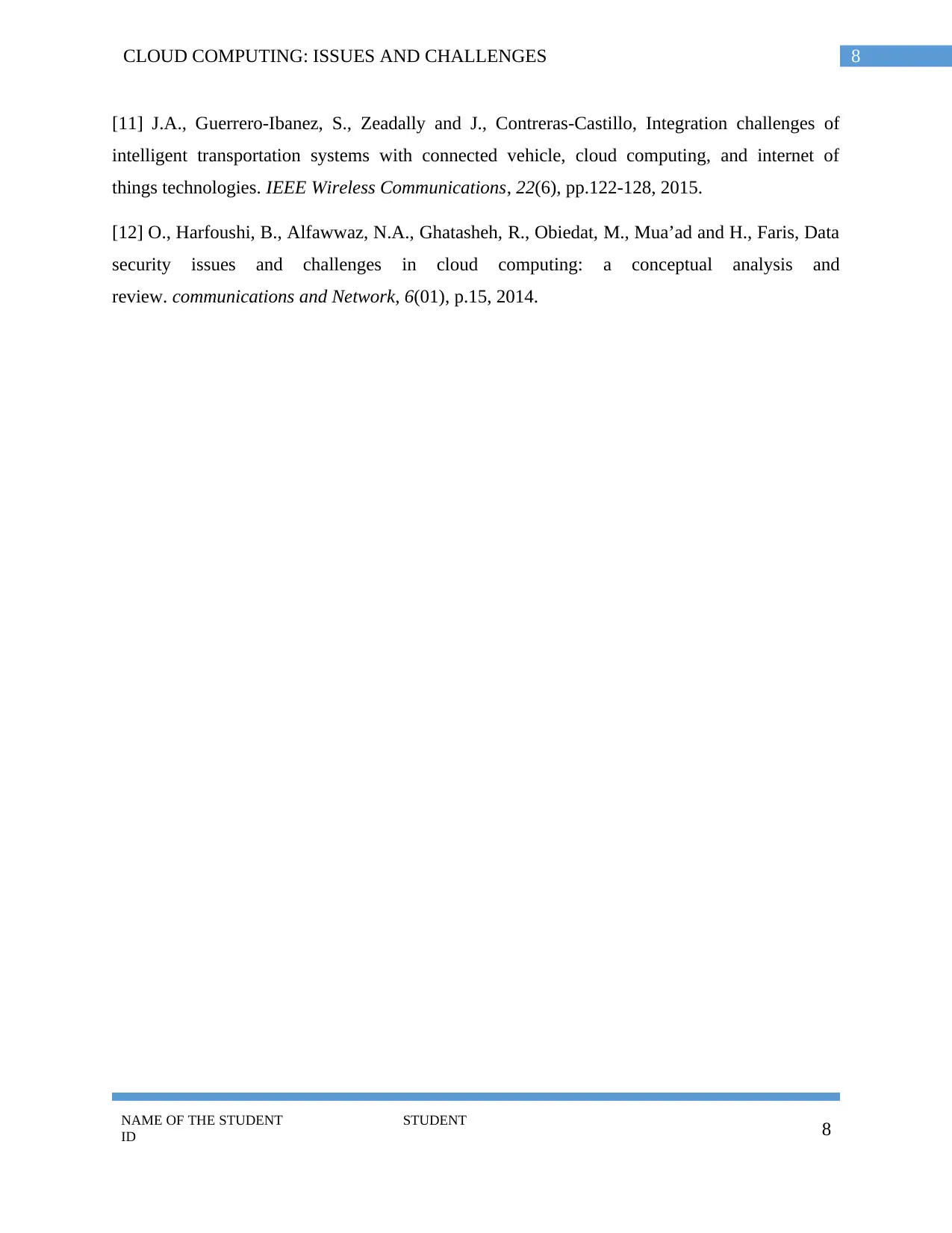
8CLOUD COMPUTING: ISSUES AND CHALLENGES
[11] J.A., Guerrero-Ibanez, S., Zeadally and J., Contreras-Castillo, Integration challenges of
intelligent transportation systems with connected vehicle, cloud computing, and internet of
things technologies. IEEE Wireless Communications, 22(6), pp.122-128, 2015.
[12] O., Harfoushi, B., Alfawwaz, N.A., Ghatasheh, R., Obiedat, M., Mua’ad and H., Faris, Data
security issues and challenges in cloud computing: a conceptual analysis and
review. communications and Network, 6(01), p.15, 2014.
NAME OF THE STUDENT STUDENT
ID 8
[11] J.A., Guerrero-Ibanez, S., Zeadally and J., Contreras-Castillo, Integration challenges of
intelligent transportation systems with connected vehicle, cloud computing, and internet of
things technologies. IEEE Wireless Communications, 22(6), pp.122-128, 2015.
[12] O., Harfoushi, B., Alfawwaz, N.A., Ghatasheh, R., Obiedat, M., Mua’ad and H., Faris, Data
security issues and challenges in cloud computing: a conceptual analysis and
review. communications and Network, 6(01), p.15, 2014.
NAME OF THE STUDENT STUDENT
ID 8
⊘ This is a preview!⊘
Do you want full access?
Subscribe today to unlock all pages.

Trusted by 1+ million students worldwide
1 out of 9
Related Documents
Your All-in-One AI-Powered Toolkit for Academic Success.
+13062052269
info@desklib.com
Available 24*7 on WhatsApp / Email
![[object Object]](/_next/static/media/star-bottom.7253800d.svg)
Unlock your academic potential
Copyright © 2020–2025 A2Z Services. All Rights Reserved. Developed and managed by ZUCOL.





